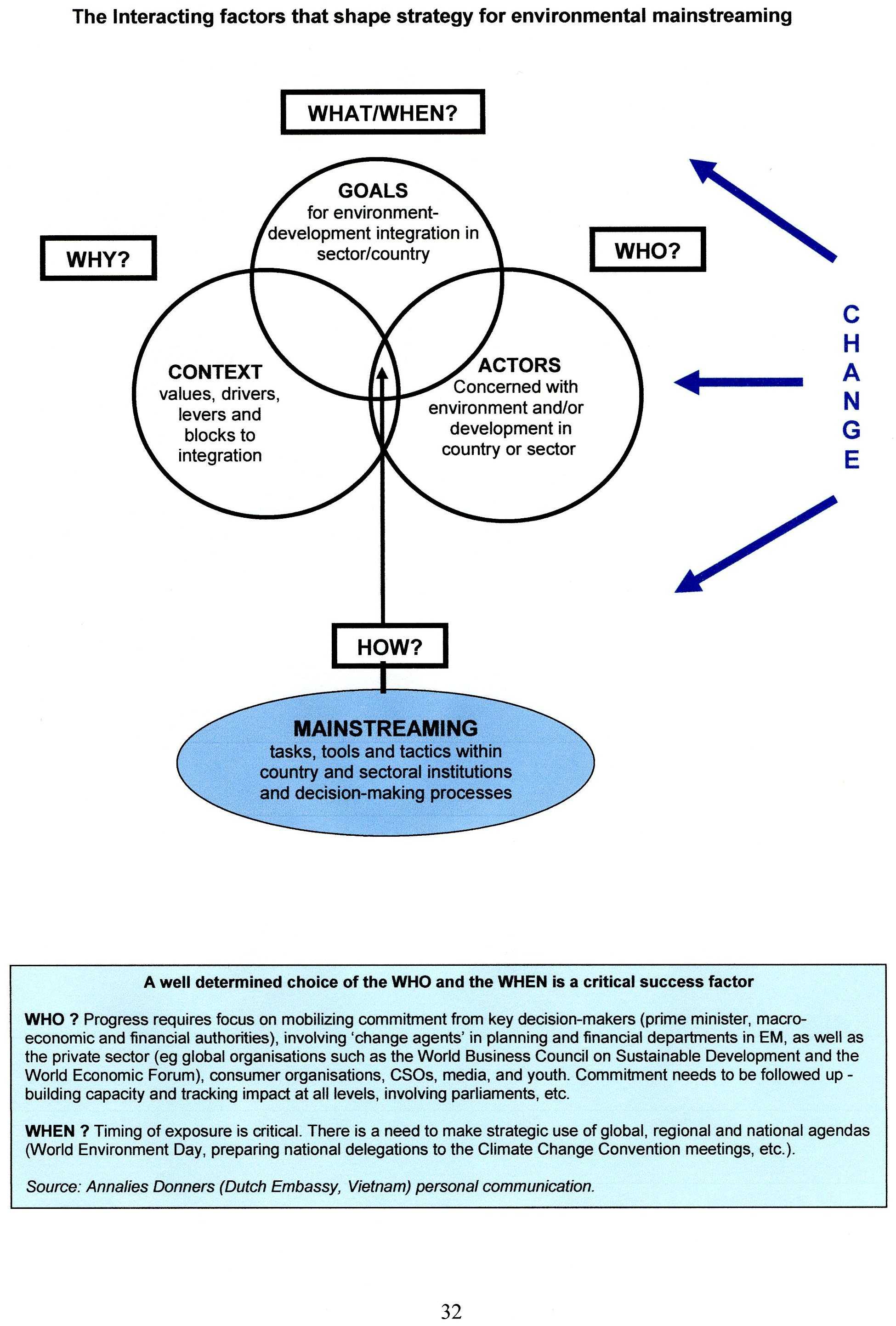|
Goals and challenges for environmental mainstreaming
The country surveys highlighted the generic complexities of mainstreaming, i.e. its multi-issue, multi-layer, context-specific nature. They revealed that issues concerning the choice of a precise tool are often less significant for mainstreaming than the need to tailor approaches to local context, to be clear on the specific mainstreaming goal, or to involve the right actor. Figure 1 presents a framework/platform for describing these dimensions.

Figure 1: Platform for environmental mainstreaming
The Panel identified examples of key goals for environmental mainstreaming (Box 1). It is envisaged that the User Guide will be of utility to most of them.
Box 1: Examples of goals for environmental mainstreaming
Integrated planning
- Integrating environment in PRSP
- Integrating environment into rural strategies
- Integrating environment into sectoral strategies and investments
- Integrating environment into cross-sector development plans and strategies
- Achieve economic development through sustainable development
Decision Making
- To improve the quality of strategic decision making
- Incorporating environmental valuation in land use decision making
Judicial
- Judicial process and the environment as an human right in constitutional law
Political Influence
- Influencing political party manifestos to incorporate environment into central planning
- Generating (broad) political understanding and awareness of environmental issues
International commitments
- Complying with international commitments
Local
- Integrating environment into local development plans and strategies
National/overarching
- Internalising and integrating concerns (beyond EIA/EMP) into major development projects
- Integrating environment into river basin/landscape management plans
- Ensure an holistic approach to development
- Evolving a common language for planning and management of development processes
- Effective and efficient land use planning
Natural Resource Management
- To ensure better management of natural resources and governing policies
- Correcting and restoring the health and productivity of the earth’s ecosystems by working with the earth’s natural carrying capacity
- Ecocentric outputs, not anthropocentric outputs
Investment
- Private sector investments made in ecosystem infrastructure
- Getting environmental and operational costs in budget
- To ensure resources allocated to environmental management
Valuation, incentives, budget processes
- Costing the value of biodiversity and incorporating into national accounting
- Getting the prices right
- Integrating into budget processes
- Technocrats are able to determine the implications of environmental policies on social and economic development and impacts of socio-economic policies on environment
- Improving/ensuring the incentives for environmentally sustainable economic development
Information, monitoring and evaluating and adaptive management
- Getting environment in development monitoring and information systems
- Improving broad access to environmental information
- Adaptive management in changing socio-political economic-environmental contexts
Institutions
- Changing institutions into action learning organisations
- Institutionalisation of environment into development management and planning processes
- Inter-sectoral and inclusive civil society and private sector
Participation and Voice
- Improving the voice of environmentally vulnerable/dependent stakeholders
- Improved meaningful participation in sustainable development planning and development at different levels
- Preventing and managing conflicts
Climate change
- Mainstreaming climate change adaptation into development and planning processes
|
Actors
The User Guide will be of help to particular categories of key actors who are likely to have a major role in environmental mainstreaming:
- Those who are responsible for the enabling conditions for mainstreaming – largely politicians and government.
- Stakeholders who are most dependent on environmental conditions and/or vulnerable.
- Major investors and users of environmental assets who create environmental change.
- ‘Tool practitioners’ who use – or should use – environmental mainstreaming tools.
- Change agents from each category.
So a key focus of the User Guide will be agents of change in decision-making – especially individuals who push for the enabling conditions for mainstreaming
|